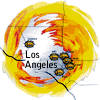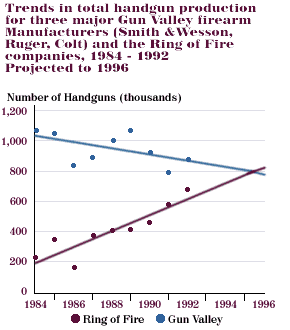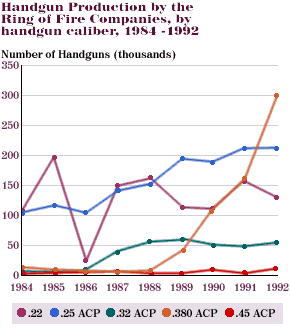
|


 The six Ring of Fire companies lie around the outer edge of the Los Angeles metropolitan area; none is more than 45 miles from downtown Los Angeles. In clockwise order from north to south, the companies are Sundance Industries, in Valencia; Arcadia Machine & Tool (AMT), in Irwindale; Phoenix Arms, in Ontario; Davis Industries and Lorcin Engineering, both in Mira Loma; and Bryco Arms, in Costa Mesa. Raven Arms was located in the City of Industry, not far from AMT.
The six Ring of Fire companies lie around the outer edge of the Los Angeles metropolitan area; none is more than 45 miles from downtown Los Angeles. In clockwise order from north to south, the companies are Sundance Industries, in Valencia; Arcadia Machine & Tool (AMT), in Irwindale; Phoenix Arms, in Ontario; Davis Industries and Lorcin Engineering, both in Mira Loma; and Bryco Arms, in Costa Mesa. Raven Arms was located in the City of Industry, not far from AMT.
How big are the Ring of Fire manufacturers? Let us consider employment first. In early 1993, Jim Waldorf of Lorcin Engineering told the Judiciary Committee of the California Assembly that his firm employed 130 people. In 1992, Lorcin produced 187,761 handguns. With the partial exception of AMT, the Ring of Fire companies produce very similar handguns by similar methods. For estimation purposes, we can therefore assume that Lorcin's ratio of persons employed to number of guns produced - 1,444 guns per employee per year - applies to the other Ring of Fire manufacturers. On that basis, these companies employed approximately 500 persons at that time.
Size can also be measured in terms of output: handgun production, in this case. In 1992, according to data supplied by BATF, the Ring of Fire manufacturers collectively produced 685,934 handguns. This was 34 percent of all the handguns made in the United States that year -more than enough to supply one to every man, woman, and child in Washington D.C., or Seattle, or New Orleans, or Milwaukee, or Boston. Ring of Fire companies made handguns enough, if each had been used to commit just one crime in 1992, to account for 74 percent of all the handgun crime in the United States that year. (This is not an entirely hypothetical consideration, as we will see in the discussion of Ring of Fire guns and crime.)
The Ring of Fire companies present a remarkable example of the concentration of one segment of a major consumer product industry in a small geographic area. At one time, U.S. production of the small inexpensive handguns known as Saturday Night Specials was largely located in south Florida. Many of these companies have gone out of business. It is no exaggeration to say that the Saturday Night Special industry now lives in Southern California.
The focus on cheap handguns turns out to have made very good business sense. Though the 1980s were not kind to the handgun industry generally, the Ring of Fire manufacturers showed sustained growth. In fact, these firms have so dramatically outperformed the rest of the handgun industry that, on the basis of number of guns produced, they will soon capture dominance of the entire industry from its traditional leadership.
Since Eli Whitney built his musket armory in New Haven in the late 1700s, the U.S. firearms industry has been headquartered along the Connecticut River in New England. Gun Valley, as it is known, is home to longtime industry giants like Smith & Wesson, Colt, and Ruger. Recent years have seen a rash of failures and buyouts in Gun Valley. Smith & Wesson is owned by a British conglomerate; Colt remains mired in bankruptcy despite massive aid from the state of Connecticut.
All the while, the Ring of Fire firms have prospered. From 1990 to 1992, their handgun production increased a remarkable 24 percent per year on average, while production for the rest of the handgun industry declined two percent per year. By 1992, Bryco, Davis, and Lorcin ranked respectively third, fourth, and fifth in number of handguns produced among all U.S. manufacturers; Phoenix ranked eighth, although it emerged from Raven's ashes only that year; AMT and Sundance ranked 16th and 17th.
The emerging industry leadership of the Ring of Fire manufacturers can be seen in the graph below. Ten years ago, Smith & Wesson, Colt, and Ruger collectively produced nearly five times as many handguns as the California manufacturers. By 1992 the gap had largely disappeared. If these trends continue, the Ring of Fire firms will surpass these three Gun Valley giants in total handgun production by 1995.

In fact, it may already have happened. While handgun sales have increased for the entire industry since 1992, evidence suggests that the Ring of Fire firms have been particular beneficiaries of this trend. The trade publication Firearms Business reported in April 1994 that one unnamed Ring of Fire company faced back orders for more than 80,000 handguns across its product line and for 50,000 guns in Just one caliber. According to Firearms Business, "[o]thers with similar lines are similarly situated. Some of the larger firms are behind by as many as 50,000 - 60,000 units."
New and More Powerful Guns
The Ring of Fire companies have by no means rested on their success in the traditional small-caliber Saturday Night Special market. Since 1988, these companies have moved very aggressively into production of medium-caliber.380 ACP.

The.380 ACP pistol can be made in nearly the same small size as the small-caliber guns with little or no loss in ammunition capacity, and is sold for only a few dollars more.
But the resemblance ends there. The.380 ACP pistol is much more powerful than small-caliber guns. By one standard ballistics measurement, Relative Stopping Power, .380 ACP ammunition has at least twice the wounding potential of the traditional Saturday Night Special calibers. The.380 ACP is considered by experts to be the most powerful ammunition compatible with the inexpensive operating mechanism found in most Ring of Fire handguns.
|